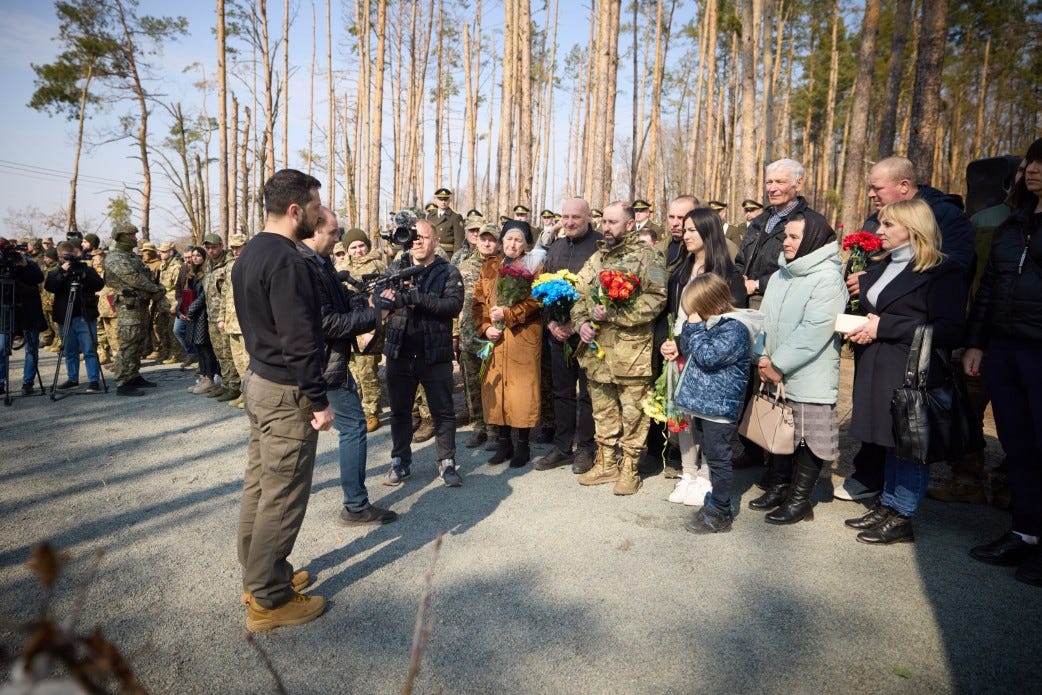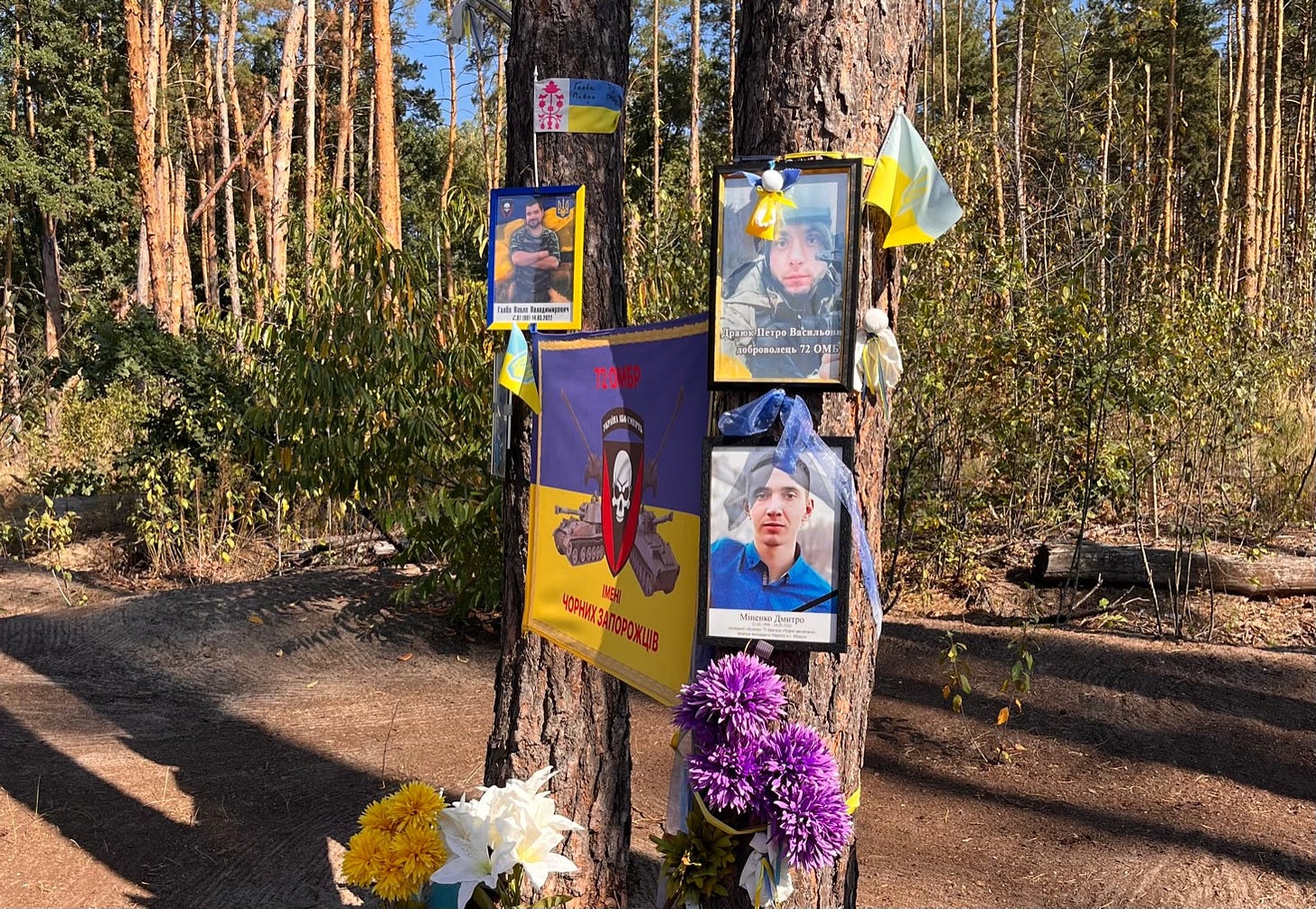This is the Battle of Moshchun, a small village that became a place of great courage, a great feat of our great people. Your great relatives and friends. A small village near Kyiv that became its great shield.
President Zelenskyy, March 2023
My visit to Ukraine continues.
I have been fortunate to have been able to speak with a range of different people, including Ministry of Defence officials, about how the war is being fought. It is providing me with greater insight into how nations face war under modern conditions, and how Ukraine is using all of its national power to resist the Russian invasion. As such, this is helping me further refine my hypothesis about a Ukrainian Way of War.
This week , I had the opportunity to conduct a visit to several areas to the north of Kyiv.
We visited Hostomel, which is a large airfield and the site of a major battle at the beginning of the Russian large scale invasion in February 2022. For an excellent account of the battle, this recent article from War on the Rocks is highly recommended. And as many will know, Hostomel is also the site of the now-wrecked heavy lift cargo aircraft, the Mriya.
But we also visited the small village of Moshchun, which is a short distance to the east of Hostomel. In the early stages of the February 2022 Russian invasion, this tiny village was the focal point for a large part of Russia’s northern army. The Russians needed the well-located village as an intermediate step on their way to the Ukrainian capital. After failing to break through Ukrainian defences around Irwin, the Russians turned their attention to an advance through Moshchun.
Nearly 30,000 Russian soldiers were involved in attempting to seize the village. This included the 76th Guards Air Assault Division, the 98th Guards Airborne Division and the 155th Separate Marine Brigade. Opposing them was a single Ukrainian mechanised brigade, the 72nd Brigade. They dug in around the town and prepared to defend against the Russian assault. The Russians conducted two weeks of vicious ground, air, rocket and artillery attacks against the Ukrainians.
There are some accounts of the battle including this piece in Small Wars Journal. The battle was also mentioned as part of a larger story about the defence of Kyiv by the Washington Post. I am yet to uncover a more detailed study of the battle. If there is one out there, please let me know.
But, the Battle of Moshchun is not just a story of military courage and tenacity.
It is also a story of how civilians and soldiers fought - and died - together defending the town. Throughout the battle, many people of the village didn’t run away. They stayed and cooked and fed the soldiers. They used their cars and trucks to haul ammunition, including the critical Javelin missiles, to forward defensive positions. Some even used Molotov cocktails against unsuspecting Russian soldiers.
Between 5 and 21 March 2022, the Russians conducted almost continuous attacks. The 72nd Brigade, with attached elements from the Territorial Defence Forces and Ukrainian special forces, held fast. Then, after two weeks and two days, the Russians withdrew. They had suffered around 600 killed and at least as many wounded. The local people, having played a key part in helping the army defend their village, immediately began rebuilding. As part of their rebuilding their village, the inhabitants of Moshchun decided to build a memorial to those Ukrainian soldiers who had given their last full measure of devotion to defend the village.
I had the opportunity to visit this memorial and discuss it with the village head. It is a lovely, poignant site. It sits atop the trench system that the 72nd Brigade constructed to defend Moshchun. The memorial is beautifully designed and maintained by the local people, and has been visited by many foreign dignitaries as well as by President Zelenskyy.

While the Battle of Moshchun is significant in the role it played in saving Kyiv, it is also representative of a larger trend in Ukraine’s contemporary way of war: a 21st century, people’s war. In many respects, Ukraine has adopted a 21st century, digitised people’s war.
The concept of people’s war was first conceived by Chinese revolutionary leader Mao Zedong. He used this approach to fight a war by maintaining popular support while drawing an enemy deep into the country side and attacking them through a mix of conventional and unconventional tactics. This had a military objective, which was to bleed the enemy of manpower and supplies. Importantly, it also had the political objective of wearing down the will of the enemy politicians and citizens.
The Chinese employed this form of war against the Japanese in the Second World War and during the Chinese Civil War.
Writing in “On Protracted War” Mao noted that:
The richest source of power to wage war lies in the masses of the people.
There is a massive irony in the democratic polity of Ukraine appropriating and re-applying an approach originally developed by a Chinese dictator for use against authoritarian Russia. There are three elements of Ukraine’s contemporary adoption of people’s war.
The first aspect is Ukraine nurturing popular support for its war effort through a focus on societal unity. This has been a theme in many of my discussions on this current visit to Ukraine. Civil society, and the unity of that society, is seen as a central, vital element of sustaining the Ukrainian war effort. As one of my interlocutors noted, it is about a mindset of “this is not mine, it is ours.”
From the beginning of this war, Ukrainian President Zelenskyy has used themes of unity, sovereignty and reinforcement of Ukrainian culture in his communication with the Ukrainian people and the world beyond. This has provided a crucial sense of purpose for soldiers and citizens. And while the Ukrainian Armed Forces have expanded significantly since the start of the war, the Ukrainian government has employed its Territorial Defence Force as an effective way for local people to contribute to the defence of Ukraine. At the same time, the Ukrainian military has taken pains to use battlefield tactics that limit casualties in order to preserve both the force and its social license with the Ukrainian people.
This popular support element of the Ukrainian people’s war has resulted in a myriad of other ways for Ukrainian citizens to directly contribute to the defence of their country. Crowd-funding has been a big effort. It has raised enormous sums to purchase everything from socks to drone, from medical kits to satellites. Smart device applications, developed by private industry and used by various parts of government, permit Ukrainians to report on enemy movements, be aware of incoming missiles, or report enemy drones and missiles flying overhead. These kinds of initiatives mean that a significantly larger proportion of society is now involved in directly supporting the war effort than in many previous conflicts.
A second element of this new-era Ukrainian people’s war has been the constant efforts to wear down of the Russian military. In earlier articles, I have described this Ukrainian approach as a strategy of corrosion. It is a focus on slowly but surely attacking the Russians physically and psychologically to destroy their combat potential. The key elements of this are the large scale ground campaigns in 2022 and 2023 which have attacked the Russians in the north, the east and south of the country. But it also incorporates maritime strikes against the Russian Black Sea fleet using drones, missiles and uncrewed attack vessels, as well as the improvements in air defence which sees the majority of Russian drones and missiles destroyed before they reach their intended targets.
In addition to these conventional attacks have been the implementation of widespread partisan activities in areas occupied by Russia. The foundation for this was provided as part of a national resistance law that was approved by President Zelenskyy in 2021 Ukrainian citizens in occupied territory provide intelligence of Russian troop concentrations, headquarters and supply dumps. These are then attacked with missiles, special forces or by the resistance members themselves. This resistance network ensures the Russians have to look to their front for attacking Ukrainians while also looking over their shoulders for partisans.
The final component of Ukraine’s information age people’s war has been its accelerating effort to corrode Russian political will and its support for the war. Early in the war, Ukraine had limited ability to conduct long range strikes against Russia, but it did have an active IT sector. It leveraged this, social media and President Zelenskyy’s speeches to implement a global strategic influence program to degrade support for Russia. This has included friendly hactivists and the global #NAFO movement to combat the widespread Russian efforts at misinformation.
Over the past six months, these political attacks on Russia have expanded and have embraced long range attacks on Moscow as well as Russian military airbases. I explored this topic in my recent articles on Ukraine’s strategic strike program. Also included in this approach have been incursions by ‘separatist’ groups into the Belgorod region earlier in 2023. The spectacular attacks conducted as part of this strategic strike campaign are designed to highlight to the Russian people the ongoing (and growing) cost of Putin’s war against Ukraine. They also aim to decrease the stature of Putin and the Russian military in the eyes of Russians - as well as in the eyes of Russia’s foreign supporters.
The new era people’s war being implemented by Ukraine is an effective strategy for a smaller country that has been attacked by a larger nation. While military forces might fight battles, it is actually nations that fight wars. Building a cohesive society, and then providing it with the right purpose, is critical in building and sustaining a nation’s war fighting capability.
The people’s war approach, of the kind demonstrated at Moshchun and many other towns and villages since, appears to be an important component of Ukraine’s modern way of war.
(You can read more about Moshchun and it’s rebuilding at the Kyiv School of Economics Rebuild UA project page).





Thanks for another excellent article and the “shout out” to NAFO. I know military establishments -- even the Russians -- plan for a myriad of scenarios, but I’d wager having your propaganda campaign derailed and defeated by a bunch of “cartoon dogs” was not one of the contemplated contingencies. Slava Ukraini!
I hadn't heard about Moshchun, thank you for that memorable description. Thirty thousand attacking soldiers for 16 days could not take the village. Do you have any sense of how many Ukrainian soldiers were defending and what were their losses?